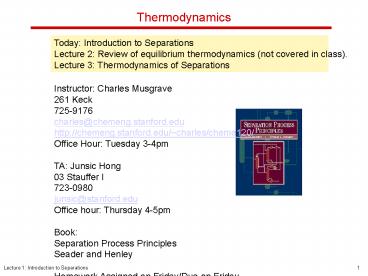Thermodynamics - PowerPoint PPT Presentation
1 / 12
Title:
Thermodynamics
Description:
Instructor: Charles Musgrave. 261 Keck. 725-9176. charles_at_chemeng.stanford.edu ... To do this we must cause differential transport of species or conversion of ... – PowerPoint PPT presentation
Number of Views:104
Avg rating:3.0/5.0
Title: Thermodynamics
1
Thermodynamics
Today Introduction to Separations Lecture 2
Review of equilibrium thermodynamics (not covered
in class). Lecture 3 Thermodynamics of
Separations
Instructor Charles Musgrave 261
Keck 725-9176 charles_at_chemeng.stanford.edu http//
chemeng.stanford.edu/charles/cheme120/ Office
Hour Tuesday 3-4pm TA Junsic Hong 03 Stauffer
I 723-0980 junsic_at_stanford.edu Office hour
Thursday 4-5pm Book Separation Process
Principles Seader and Henley Homework Assigned
on Friday/Due on Friday
2
Introduction to Separations
The goal of a separations process is to purify
solutions.
To do this we must cause differential transport
of species or conversion of species so that the
purer mixtures can be collected. Most
separations processes involve differential
transport.
ExamplesSeparation of bloodPurification of
drugsPurification of Au, Si, GaAsRefining of
crude oilDNA testingPurification of
organicsPurification of waterSmog control
separated
mixed
However, mixing is inherent in nature The
increase in entropy associated with the
randomness of a mixturelowers the Gibbs free
energy. Therefore, to unmix a solution we must
overcome the entropic driving force to mix.
3
Why Separate?
There are many reasons for wanting pure
substances. Some of these reasons include
Need for pure material in engineering application
(semiconductors) Preparation of raw materials
into their components Need for pure material
for materials processing Need to remove
toxins or inactive components from solution
(drugs) Need for ultrapure samples for
testing Need for analysis of the components of
the mixture (DNA testing) Based on these
motivations for separations, we can divide
separations up into three main areas
Industrial Separations large scale economical
Analytical Separations small scale
quantitativeanalysis
Preparative Separations small scale materials
for RD
ExampleCentrifugation
ExampleDistillation
ExampleChromatography
The list of different existing separations
methods is limitless. Therefore we will
emphasize the fundamentals of separations.
Note 50 to 90 percent of capital investment in
chemical plant is for separations equipment.
4
Background Material for Separations
The fundamentals that we will apply to study
separations in this course involve Materials
and energy balances conservation of energy and
matter Thermodynamics phase equilibrium and
solution thermodynamics (Chapter 2) Transport
phenomena (Chapter 3 not emphasized) Chemical
reaction kinetics rate of conversion of one
species to another (not emphasized)
For the most part our analysis of various
separations processes will focus on using phase
equilibrium and materials and energy balances.
5
Basic Description of Operations
Separations processes can be run in various modes
of operation Batchwise no flows
Continuous continuous flows in and out of
separators Semicontinuous pauses in
flows. Operations are classified as key
operations and auxiliary operations Key
Operation involves reaction or
separations Examples distillation, leaching,
reactor Auxiliary Operation involves no
change in chemical composition Examples pumps,
heaters, compressors Block Flow Diagrams
indicate Key Operations by rectangles and
Flows and Streams by lines Process Flow
Diagrams indicates processes by Realistic
symbols of process equipment Including
auxiliary operations
6
Basic Description of Operations
Process Flow Diagram
Block Flow Diagram
S1
P1
Total condenser
Distillation
Distillation
Reflux drum
Overhead vapor
1
Reflux
F
Distillate
2
Feed Stage
Feed
Boilup
N
Stripping section stages
Partial reboiler
Bottoms
S2
P2
7
Example
Example Recovery of hydrocarbons from wet
natural gas (wng) These types of separations
generally exploit the differences in volatility
to cause a separation
methane
C2
ethane
Feed wng
C2/abs
C3
absorber
i-butane
n-butane
C4
C4
propane
C5
Notice that this process involves a train of
separators This is common in industrial
processes.
8
Mechanism of Separations
UNMIXING is not a spontaneous process in nature
A process requiring no external driving force
Reduces randomness and thus the entropy of the
system
Separations involve nonspontaneous processes
Usually the mixture to separate is a homogeneous,
single phase If not, then often one will phase
separate first
gravity centrifugation filtration.
Product 1
Product 2
Feed S, L,V ci
Product 3
Differ in concentrations, may differ in phase
state
Separator Causes different chemical components
to move to different spatial locations to be
collected as more pure mixtures Differential
Transport.
9
Main Separations Techniques
Phase Creation Use ESA (heat or
depressurize) Phase Addition Use MSA (add
solvent or absorber) Barrier Separation Use
membrane (semipermeable membrane) Solid Agent
separations Use particles (reaction, absorbent
film, direct absorption, chromatography)
Separation by gradient Use electric field,
magnetic field, gravity (Hall effect,
electrophoresis, mass spec)
Phase Creation Phase Addition Barrier
Separation Solid Agent separations Separation
by gradient
Most Common
Gaining popularity
Often in labs
All five techniques rely on the ability to
enhance the rate of mass transfer of
certainspecies relative to others to effect a
spatial separation of components.
Thus, all separations processes must introduce a
thermodynamic driving force to overcome the
decrease in the entropy of the system as the
components are separated.
10
Thermodynamics of Separations
Remember that there is an infinite driving
force associated with removing the last impurity
atom from a pure substance
?SM
G
0
1
XB
XB
0
1
Since the driving force to mix will eventually
equal the driving force we introduced to cause
the separation the extent of separation will be
limited by thermodynamics equilibrium!
11
Rate of Separations
Although the extent of a separation is determined
by thermodynamics, the rate of separationsis
limited by the differential rate at which the
different species are moved. That is The Rate
of Separation is limited by Mass Transport.
Limits Extent Thermodyanmics Rate Transport
In this course we will generally focus on the
thermodynamic fundamentals governing separations.
Transport issues will be addressed, but not a
focus.
12
Thermodynamics
Next Thermodynamics of Separations Lecture 2
Review of equilibrium thermodynamics (not covered
in class). Lecture 3 Thermodynamics of
Separations Before Next lecture Read Lectures 2
and 3 (see course webpage) Review Thermodynamics
(some notes available on course
webpage) Equilibrium Entropy Solution
Thermodynamics Activity and Activity
Coefficients Equilibrium Phase Diagrams
















![L 18 Thermodynamics [3] PowerPoint PPT Presentation](https://s3.amazonaws.com/images.powershow.com/6877662.th0.jpg?_=20150709116)














